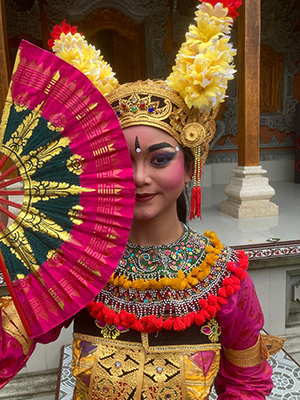Robin Osborne fell in love with Bali in 1971 and still finds it a place of wonder.
Well I wandered off to Ubud, just a little up the track
One week there didn't want to come back…
Redgum (1984) - “I’ve been to Bali too”
Bali has many faces and one of them continues to be the Kuta beach area, anthemically captured by Redgum, where bars pump out loud music and Bintang beer for youthful tourists, mostly from Australia, on what is often their first visit to this memorable Indonesian island.
Sadly, it is also the site of the 2002 terrorist bombing that killed 202 people. Lest we forget.
Far away – by winding road if not as the crow flies – lies the elevated town of Ubud, nowadays with luxurious hotels and yoga studios, but a cultural and climatic relief from the frantic coastal strip.
The commercial centre is bounded by Monkey Forest Road, a name unaccountably rendered in English, and Jalan Hanuman (after the white king of the monkeys in the Hindu Ramayana epic). It is lined with shops, ranging from the classy to the tacky, and a swag of cafes and restaurants. The footpaths are crowded now, and still unspeakably bad, but surprisingly close by lie flooded rice fields where ducks dive for frogs and insects, watched by egrets who survive on the leftovers.
Around these paddies, which can grow two crops a year, Balinese rural life goes on, and one wonders where and how the farmers actually live. Surely not in the rundown huts in the middle of the fields? No, these are for the ducks, which emerge in single file each morning, forage all day and then line up for a supplementary snack and containment for the night. I enjoy watching them so much that I have never been able to order bebek betutu, roast duck, a Balinese specialty.
As fascinating as it is to watch this ritual from one’s hotel veranda, it is only a glimpse of agrarian life, a picture better completed by taking one of the few genuine village tours on offer, in this case by a not-for-profit called the Togetherness Project that is based in Pesalakan, a village 15 minutes from central Ubud yet a world away.
The half-day tour begins with early morning hotel pickup and transfer to a local family compound within the village, where coffee is served and an explanation given about how Balinese walled compounds function. Then comes a guided walk to view rice fields and vegetable gardens, before returning for a splendid lunch made from local produce, and a traditional dance from the 14-year-old niece of our guide, accompanied by taped gamelan music.
For visitors unlikely to see how the ‘real Bali’ functions, which is probably most of us, this experience cannot be more highly recommended. The project started during COVID-19 when Bali went into lockdown and tourism income dried up. Like many parts of the island, locals would spend part of their time in paid employment outside of the village.
The catalyst was David Metcalf, a foreign photographer who approached Made Astawa, the leader of the village council, or banjar, and asked what he might do to help during the crisis. Teaming up with another part-time resident, Suzan Badgley from Canada, he set up a fund, sought donations from abroad and identified employment creation as a first priority.
In years past, textile weaving with silk and cotton brocade had been a creative focus, and the local master weaver, Ibu Agung, and other women were encouraged to revive their efforts and pass their skills to a younger generation. Handlooms were brought out of storage, extra looms acquired, and cotton and silk thread bought at nearby markets.
Since the cottage industry in woven ikat textiles has been revived, the sale of these beautiful pieces of art has helped revive the village’s sustainability.
Another initiative has been the project known as “Plastic for rice”, inspired by a local deeply troubled by the accumulation of non-destructible waste, notably plastics. The collected trash is handed to a rubbish bank and sold to a recycling company. Already, more than two tonnes of garbage have been cleaned up from village centres, rice fields and waterways, with communities trading it for sacks of rice grain.
During our walk we saw a graphic noticeboard outside a primary school, headed ‘How long rubbish lasts’. It featured samples of common waste, including plastic water bottles, aluminium cans, and cigarette butts, along with their projected life spans, respectively 450, 200 and 10 years. Amidst the ancient beauty of Bali, this was one of my most vivid memories. I would like to see these simple signs outside every supermarket in Australia.
Waste of a more biodegradable and cultural kind littered the side roads where a few days earlier a mass cremation ceremony had been held. A swathe of handcrafted religious items made of shaved bamboo, palm leaves and brightly coloured paper, not to forget a decomposing pig’s head, had survived the fire but would soon be reburned.
"We live and then we die,” said Wayan, our guide, matter of factly, explaining that only the very rich could afford a one-person funeral ceremony, which could cost up to A$10,000. More usually, there would be a group ceremony with ten or more families burying their dead for long enough to save money, and then exhuming the remains and contributing to a mass ceremony, including cremation and transporting the ashes to the distant ocean for dispersal.
The transience of life is never far from one’s thoughts here, especially as there’s no chance of living as long as a plastic water bottle.
















